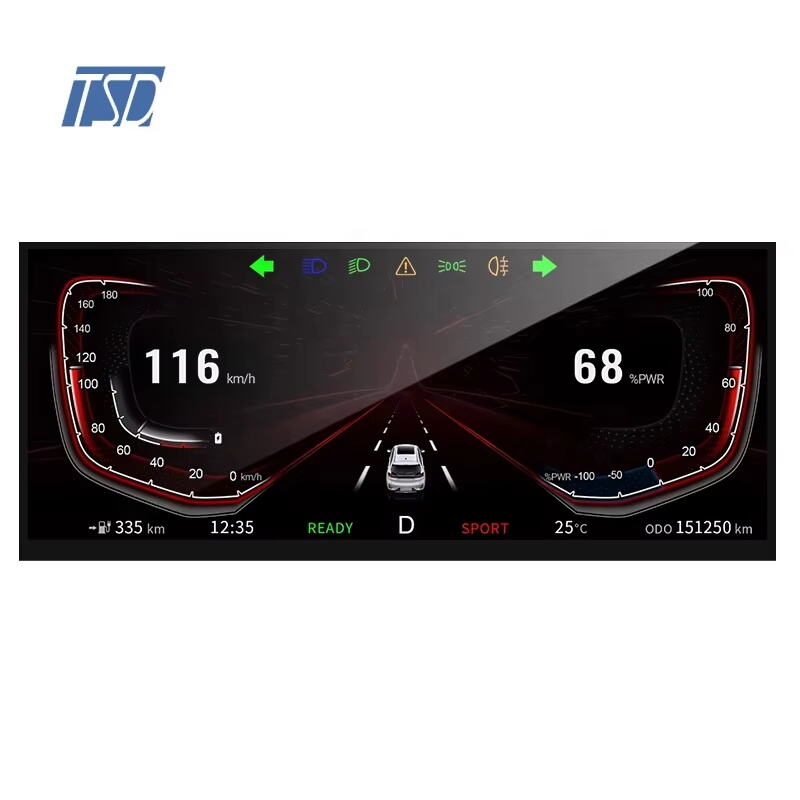Introduction: The Growing Importance of Automotive LCD Display Modules
Defining the Role of LCD Modules in Modern Vehicles
LCD display modules have become pretty much essential in today's cars, serving as the main control centers for everything from basic settings to entertainment systems and GPS navigation. Drivers these days rely on these screens to tweak their car's options, watch videos, listen to music, and get directions while on the road. When manufacturers start putting these digital panels in place of old fashioned gauges, it makes the dashboard look sleeker and definitely feels more up to date. Industry reports show that around 8 out of 10 new cars coming off assembly lines now feature some kind of LCD screen somewhere in the cockpit. Makes sense really, since people want their cars to match the tech they carry around in their pockets every day.
Market Growth Projections for In-Vehicle Infotainment Systems
The in-car entertainment systems sector looks poised for major expansion in coming years according to recent market analysis. What's driving this surge? Simple really - people want better screens in their vehicles that deliver sharper visuals and richer content. Take a look at numbers from Future Market Insights: they predict the auto display market will jump from around $42 billion back in 2025 all the way up to nearly $75 billion by 2035, growing at roughly 6% each year. Car buyers today are clearly hooked on those fancy LCD panels. Automakers get this too, which explains why so many are pouring money into developing cutting edge tech for dashboards. We're seeing everything from AR navigation overlays to full blown heads up displays becoming standard features as companies race to catch up with what customers now expect when shopping for their next ride.
Enhanced Driver Experience Through Advanced Integration
Navigation System Integration and Real-Time Updates
Navigation systems built into cars really boost how happy drivers are and make roads safer because they give accurate directions and update about traffic situations. Real time info from places like Google Maps means drivers get up to date details about what's happening on the roads, changes in traffic flow, and where to go next, which makes trips less stressful. A study from Navigant Research now part of Guidehouse found around 90 percent of people depend a lot on GPS and navigation tools when driving. That shows why having good navigation built into cars matters so much these days for anyone buying or using modern vehicles.
Seamless Multimedia Streaming & Connectivity Solutions
Modern car LCD screens work well with all sorts of streaming services, giving both driver and passengers good entertainment options while on the road. Systems like Apple CarPlay and Android Auto changed how people interact with their cars, making it easy to get at apps and media right from the dashboard display. More folks are looking for cars that pack serious multimedia punch these days. According to recent market research from Voicebot.ai, there's definitely rising interest in built-in streaming features throughout car entertainment systems. People just want to stay connected no matter where they're going.
Vehicle-to-Everything (V2X) Communication Capabilities
V2X communication plays a big role in making our roads safer and traffic move smoother these days. With those fancy LCD screens now common in cars, important V2X info gets shown right to drivers so they actually see what's going on around them and know how to respond when conditions change. Research shows these systems really do cut down on crashes because cars talk to each other and the road infrastructure better than before. The way this data flows into car displays marks real progress toward keeping drivers not just aware but actually safer while driving. Some folks still question exactly how much difference it makes day to day, but most agree it's definitely moving us in the right direction.
Advanced Features Revolutionizing User Interaction
High-Responsiveness Touchscreen Interfaces
Touchscreens in cars that respond quickly are changing how people interact with their vehicles, making controls feel much more natural and straightforward. The tech behind them has gotten better over time, so there's far less delay when someone touches the screen. Recent studies show drivers are happier with cars that have these advanced displays, mostly because they find it easier to navigate menus and adjust settings while driving. Car makers are spending money on upgrades for both the software running on these screens and the actual hardware underneath. They want to make sure everything works smoothly together. Some companies are even starting to use faster processors and more responsive touch sensors just to give users that extra bit of convenience without any frustrating delays.
AI-Powered Voice Control Systems
Voice controlled systems powered by artificial intelligence are changing the game for drivers wanting to stay safe while behind the wheel without having to take their hands off the steering wheel. The tech inside these systems gets better at understanding what people say and carrying out commands properly, which helps keep eyes on the road instead of fiddling with buttons. Research indicates that when drivers use voice controls more often, there tends to be fewer cases where they get distracted from driving tasks. Most modern cars now come equipped with basic functions like setting the cabin temperature, getting directions via built-in maps, and controlling audio playback all through simple spoken instructions. And we're only seeing the beginning here since improvements in AI mean these voice interfaces should get smarter and work better over time, making them an essential part of next generation vehicle design.
Gesture Recognition and Haptic Feedback Technologies
Hands free control of vehicle systems through gesture recognition tech lets drivers keep their eyes on the road while still getting to those important functions. With this tech, people can manage things like music or climate controls just by moving their hands around, which definitely makes for safer driving conditions. Haptic feedback works alongside these gestures too, giving drivers actual physical confirmation when something gets done right. Most folks actually report feeling better about using cars that have both gesture controls and haptic responses because it just feels more natural and works better overall. As car manufacturers continue developing smarter interfaces, we're seeing real progress toward creating vehicles where everything from navigation to entertainment integrates seamlessly without distracting the driver.
Superior Display Quality for Optimal Performance
4K Resolution and HDR Compatibility
Luxury cars have gotten a major upgrade in recent times with the introduction of 4K resolution screens. These displays pack in way more pixels than standard ones, so everything looks crystal clear from the driver's seat. Navigation maps become almost lifelike, videos play without any graininess, and even basic infotainment features look much sharper than before. The addition of HDR support makes colors pop and contrasts stand out whether driving through bright sunlight or under dim streetlights. Market research shows that buyers are increasingly drawn to these top quality screens when shopping for expensive cars. As a result, manufacturers are seeing rising orders for advanced automotive LCD modules capable of delivering that wow factor on the road.
Wide Viewing Angles & Anti-Glare Surface Treatments
Good viewing angles make a big difference in how passengers experience vehicle displays and ensure important info stays visible no matter where someone sits or what time it is. When everyone can see the screen clearly without obstruction, safety improves and overall satisfaction goes up during trips. Anti-glare coatings on screens have really taken off in recent years as part of display tech improvements. The coatings cut down on annoying reflections so people can actually read what's on screen even when driving under harsh sunlight conditions that typically cause problems. Most drivers complain about glare issues, which explains why manufacturers keep working on better solutions for this problem in car display designs.
Adaptive Brightness for Day/Night Driving Conditions
Adaptive brightness tech is really changing how we interact with car screens these days. The system basically tweaks screen brightness depending on what's going on outside the windshield, so drivers can see clearly without squinting or getting blinded. Behind the scenes, there are little sensors working overtime to spot when daylight fades or headlights shine directly onto the dash, then they either crank down or boost the screen glow accordingly. These kinds of adjustments matter because nobody wants to fight with unreadable menus while trying to stay focused on the road ahead. Research shows around 30% of all dashboard complaints come from poor lighting situations, which makes sense when considering how many accidents happen due to drivers looking away from the road to read something important.
Emerging Trends in Automotive Display Technology
Curved LCD Displays for Ergonomic Dashboards
Curved LCD screens are changing how cars look inside while also making them better to use. The way these screens fit into dashboards creates a much smoother look that actually matches how people sit in vehicles today. Drivers find it easier to see what's going on because everything lines up naturally in front of them, so they don't have to twist their necks around as much when driving. That makes for safer trips overall and just feels more comfortable too. Auto manufacturers have noticed this shift happening across the board lately. People want their cars to look good but still work well, and curved displays check both boxes at once. With so many consumers asking for nicer looking interiors that still function properly, it seems pretty clear that we'll be seeing these curved screens everywhere in new car models soon enough.
Multi-Screen Configurations and Digital Cockpits
Multi screen setups are changing how people experience driving and laying groundwork for what we now call digital cockpits in today's cars. With several displays on board, both drivers and passengers can access different functions at once. Navigation gets better, entertainment options expand, and important information about the car's performance becomes readily available right there on the dashboard. These digital cockpits basically replace traditional instrument clusters with something much more advanced. They bring together everything from music players to safety alerts and engine diagnostics all in one place. Car manufacturers report that sales of vehicles with multiple screens keep rising as consumers want more from their rides. The tech isn't just fancy anymore either. Most new models coming out now include some form of this setup, showing just how fast the market is moving toward fully connected driving experiences.
FAQ
What are automotive LCD display modules?
Automotive LCD display modules are digital screens used in vehicles for controls, infotainment, and navigation purposes. They enhance the aesthetics and functionality of a vehicle's dashboard.
How do LCD modules benefit modern vehicles?
LCD modules in modern vehicles serve as central interfaces, allowing drivers to manage vehicle settings, multimedia content, and navigation information effortlessly, thus enhancing the driving experience.
Why is there a growing interest in high-resolution automotive displays?
High-resolution displays, such as 4K resolution and HDR compatibility, provide enhanced visual clarity and color richness, significantly improving the visual experience for drivers and passengers.
How does adaptive brightness technology work?
Adaptive brightness technology adjusts the display's brightness based on ambient light conditions, optimizing visibility for drivers during both day and night driving scenarios.
What are OLED and hybrid display solutions?
OLED displays offer superior color accuracy and energy efficiency but are costly. Hybrid solutions merge the strengths of OLED and LCD technologies, providing a balance between performance and cost-effectiveness.




